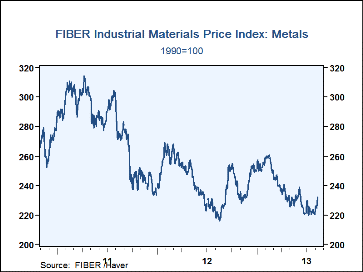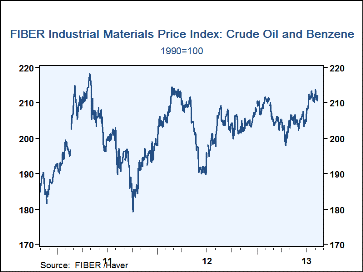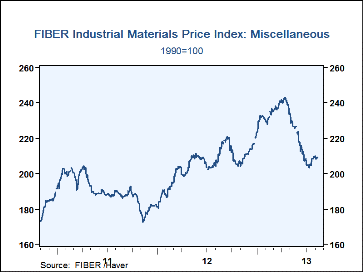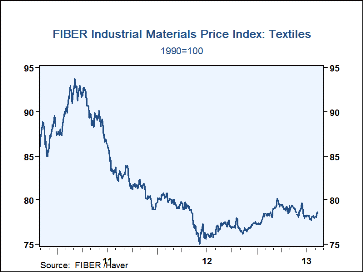 Global| Aug 12 2013
Global| Aug 12 2013FIBER: Industrial Commodity Prices Show Improvement
by:Tom Moeller
|in:Economy in Brief
Summary
Following softness earlier this year, the recent firming of industrial commodity prices indicate that a corner toward improvement has been turned. Friday's industrial commodity price index, from the Foundation for International [...]
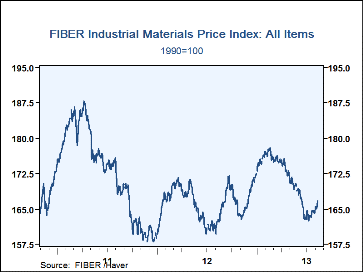 Following softness earlier this year, the recent firming of industrial
commodity prices indicate that a corner toward improvement has been
turned. Friday's industrial commodity price index, from the Foundation for
International Business and Economic Research (FIBER), was 166.0, up 2.0%
from early-July.
Following softness earlier this year, the recent firming of industrial
commodity prices indicate that a corner toward improvement has been
turned. Friday's industrial commodity price index, from the Foundation for
International Business and Economic Research (FIBER), was 166.0, up 2.0%
from early-July.
Price improvement has been across the component series. In the metals group, prices have risen an average 13.0% since late last month. The gain has been led by an increase in prices for copper scrap, lead and zinc. Also, earlier declines in aluminum and steel scrap prices have stabilized. Though they've weakened just recently, prices in the crude oil and benzene grouping have risen 5.4% from mid-April. The gain has been led by a 20.0% jump in the price of crude oil to $106.00 per barrel. Soft prices for the petro-chemical benzene have countered the rise.
Improved pricing power extends to other groupings. Prices in the miscellaneous area have risen 3.0% since mid-July. Higher wood prices account for the strength as framing lumber and structural panel costs have jumped 8.0-to-10.0%. Regardless, these prices remain down by one-quarter from their peaks this past spring. Natural rubber prices have stabilized recently but are down sharply from the January highs. Also moving 1.0% upward have been textile prices. The gain here has been led by a 7.0% jump in cotton prices in the last three weeks. The earlier sharp decline in burlap prices has stabilized.
The current industrial output forecast from the National Association for Business Economics calls for 3.1% growth this year but then a pickup to 3.5% in 2014. These growth rates suggest some future firming of industrial commodity prices. During the last ten years there has been a 42% correlation between the three-month change in prices and the change in factory sector industrial production.
Commodity price data can be found in Haver's DAILY, WEEKLY, USECON and CMDTY databases.
| FIBER Industrial Materials Price Index (1990=100) | 08/08/13 | Y/Y % | 2012 | 2011 | 2010 |
|---|---|---|---|---|---|
| All Items | 166.0 | 2.2 | 166.4 | 173.0 | 157.9 |
| Textiles | 78.6 | 1.8 | 77.9 | 86.1 | 81.3 |
| Cotton (cents per pound) | 79.8 | 20.7 | 74.5 | 132.8 | 87.8 |
| Metals | 228.6 | 3.5 | 243.0 | 278.7 | 240.0 |
| Aluminum ($ per metric ton) | 1,772.0 | -5.1 | 2,019.6 | 2,400.9 | 2,172.1 |
| Copper Scrap (cents per pound) | 314.0 | -8.8 | 360.6 | 400.3 | 326.8 |
| Steel Scrap ($ per ton) | 324.3 | -6.7 | 366.7 | 412.6 | 326.5 |
| Crude Oil & Benzene | 210.8 | 2.1 | 204.1 | 199.3 | 182.0 |
| Crude Oil (WTI, $ per Barrel) | 106.4 | 18.3 | 94.2 | 95.0 | 79.4 |
| Miscellaneous | 209.5 | 1.3 | 205.3 | 190.6 | 179.1 |
| Framing Lumber ($ per 1000 board ft.) | 335 | 5.0 | 321 | 273 | 283 |
| Natural Rubber (cents per pound) | 176.0 | -13.1 | 211.9 | 262.3 | 182.9 |
Tom Moeller
AuthorMore in Author Profile »Prior to joining Haver Analytics in 2000, Mr. Moeller worked as the Economist at Chancellor Capital Management from 1985 to 1999. There, he developed comprehensive economic forecasts and interpreted economic data for equity and fixed income portfolio managers. Also at Chancellor, Mr. Moeller worked as an equity analyst and was responsible for researching and rating companies in the economically sensitive automobile and housing industries for investment in Chancellor’s equity portfolio. Prior to joining Chancellor, Mr. Moeller was an Economist at Citibank from 1979 to 1984. He also analyzed pricing behavior in the metals industry for the Council on Wage and Price Stability in Washington, D.C. In 1999, Mr. Moeller received the award for most accurate forecast from the Forecasters' Club of New York. From 1990 to 1992 he was President of the New York Association for Business Economists. Mr. Moeller earned an M.B.A. in Finance from Fordham University, where he graduated in 1987. He holds a Bachelor of Arts in Economics from George Washington University.


